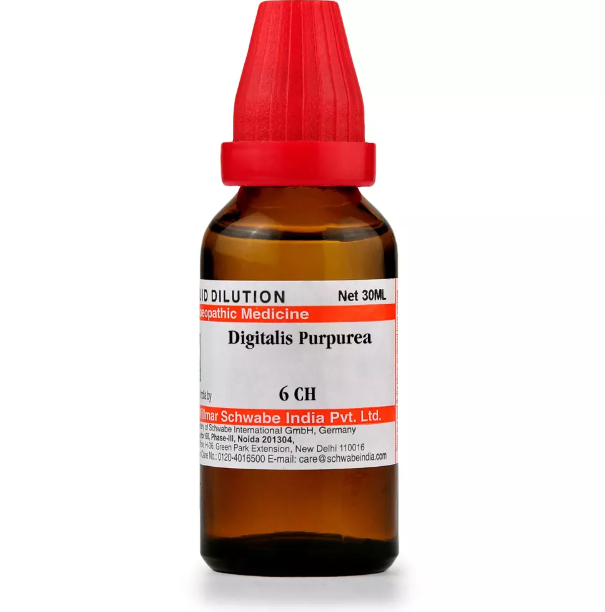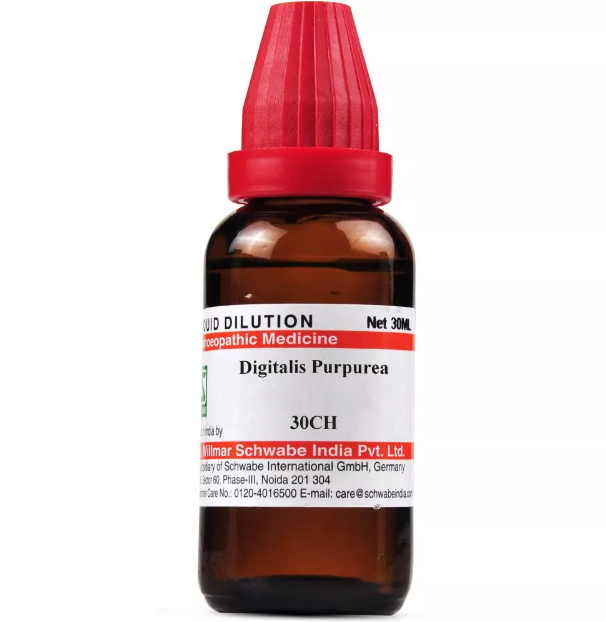DIGITALIS PURPUREA Q, 6C, 12C, 30C, 200C, 1M, 10M USES AND SYMPTOMS
 DIGITALIS PURPUREA
DIGITALIS PURPUREA
(Foxglove)
Dig.
Used for diseases involving the heart, particularly with a weak, irregular, or slow pulse, and external or internal dropsy. Treats myocardial weakness and dilation, with the primary indication being compensation failure, especially in auricular fibrillation. Notable for slow pulse when lying down, which becomes irregular when sitting up. Effective for auricular flutter and fibrillation after rheumatic fever, heart block, and very slow pulse. Symptoms of organic heart disease include great weakness, faintness, cold skin, irregular breathing, cardiac irritability, and eye issues after tobacco use. Also indicated for jaundice due to liver induration and hypertrophy, often associated with heart disease. Symptoms include a faint, dying feeling, cyanosed face, and cardiac muscular failure with asystole. It stimulates heart muscles, enhances systole force, and prolongs systole. Other signs include exhaustion from minor effort and collapse.
Mind: Despondency, fearfulness, anxiety about the future, dull senses, epigastric shocks, melancholia, lethargy, and a slow pulse.
Head: Vertigo when walking or rising, with cardiac and hepatic issues. Sharp frontal pain extending to the nose after consuming cold water or ice cream. Head heaviness, bluish face, confusion, fullness, noises in the head, cracking sounds during naps, and blue tongue and lips.
Eyes: Blue eyelids, dark spots like flies before the eyes, altered perception of green shades, objects appearing green and yellow, mydriasis, red and swollen lid margins, morning agglutination (blepharitis), retinal detachment, dim vision (amaurosis), irregular pupils, and diplopia.
Stomach: Sweet taste with constant salivation, excessive nausea unrelieved by vomiting, faintness, stomach weakness, burning extending to the esophagus, forehead pain after cold drinks or ice cream, faintness, and vomiting from motion. Discomfort from small food amounts or even sight or smell of food, epigastric tenderness, copious salivation, and neuralgic stomach pain unrelated to food intake.
Abdomen: Pain on the left side, in the descending colon and under false ribs, severe pain, abdominal aorta pulsations, epigastric constriction, enlarged and painful liver (jaundice).
Stool: White, chalk-like, ashy stools, diarrhea during jaundice.
Urinary: Continuous urging, dark, hot, burning urine with sharp pain at the bladder neck, worse at night, suppressed, ammoniacal, turbid, urethritis, phimosis, strangury, fullness after urination, burning, and constriction. Brick-dust sediment.
Male: Nocturnal emissions with genital weakness post-coitus, hydrocele, scrotum like a bladder, gonorrhea, balanitis with prepuce edema, and dropsical genital swelling.
Female: Labor-like pains in the abdomen and back before menses, uterine hemorrhage.
Respiratory: Desire for deep breaths, irregular and difficult breathing, deep sighing, cough with sore chest, sweetish expectoration, senile pneumonia, chest weakness, dyspnea, constant deep breath desire, compressed lung feeling (asthma), chronic bronchitis, passive lung congestion with bloody sputum from failing myocardium, and inability to talk. Hemoptysis with a weak heart.
Heart: Movement causes violent palpitations, sensation of ceasing heartbeat with movement, frequent heart stitches, irregular heart due to mitral disease, slow pulse, cyanosis, pulse inequality, sensation of heart standstill, weak and quick pulse with movement, pericarditis with copious exudation, dilated heart with slow, feeble pulse, hypertrophy with dilation, cardiac failure post-fever, cardiac dropsy.
Extremities: Swelling of feet, easily asleep fingers, cold hands and feet, rheumatic joint pain, shiny white joint swelling, muscular debility, nocturnal finger swelling, red hot wire sensation through legs.
Sleep: Starts from sleep in alarm, fearing falling from a height, continuous sleepiness.
Fever: Sudden heat flushes followed by great nervous weakness.
Skin: Deep red erythema, worse on the back, blue distended veins on lids, ears, lips, and tongue, dropsical, itching, and jaundiced.
Modalities: Worse when sitting erect, after meals, and with music. Better when stomach is empty and in open air.
Relationship: Antidotes: Camph., Serpentaria aristolochia. Incompatible: Chin. Compare: Nerium odorum (resembles Dig. in heart symptoms and acts like strychnia on the spinal cord with upper body spasms, palpitations, and strengthened weak heart), Adon., Crat., Kalm., Spig., Liatris spicata. Compare Digitoxinum for marked yellow vision and nausea worsened by champagne. Nitri spiritus dulcis increases Dig. action. Ichthyotoxinum; Eel serum (resembles vipera venom, indicated for insufficient systole, decompensated valvular disease, irregular pulse due to auricular fibrillation, asystole, frequent irregular pulse, dyspnea, scanty urine, enlarged liver, dyspnea, albuminuria, no edema). Convallaria majalis (heart disease with vertigo and digestive issues). Quinidinum (restores normal rhythm in auricular fibrillation, supplements Dig. action, dosage details provided).
Dose: Third to thirtieth attenuation for homeopathic reaction; physiological dosage for palliation. Tincture from fresh plant, 5-20 drops for cardiac stimulation or 1½% infusion, ½-1 ounce for diuretic action. Tincture may be given on sugar or bread, no liquids for 20 minutes before/after. Powdered leaves, ½-2 grains in capsules. Digitoxinum 1/250 grain. Reduce dose as pulse reaches 80 beats/min and normal rhythm is restored. Cut dose further if urinary output suddenly falls.
SYMPTOMS OF DIGITALIS PURPUREA
Mind:
Despondency, fearfulness, anxiety about the future
Dull senses, shocks felt in the epigastrium
Melancholia, lethargy with a slow pulse
Head:
Vertigo when walking or rising, with cardiac and hepatic issues
Sharp frontal pain extending to the nose after consuming cold water or ice cream
Head heaviness, bluish face, confusion, fullness, noises in the head
Cracking sounds during naps, blue tongue and lips
Eyes:
Blue eyelids, dark spots before the eyes
Altered perception of green shades, objects appearing green and yellow
Mydriasis, red and swollen lid margins, morning agglutination (blepharitis)
Retinal detachment, dim vision (amaurosis), irregular pupils, diplopia
Stomach:
Sweet taste with constant salivation, excessive nausea unrelieved by vomiting
Faintness, stomach weakness, burning extending to the esophagus
Forehead pain after cold drinks or ice cream, faintness and vomiting from motion
Discomfort from small food amounts or sight/smell of food
Epigastric tenderness, copious salivation, neuralgic stomach pain unrelated to food
Abdomen:
Left side pain, in the descending colon and under false ribs
Severe pain, abdominal aorta pulsations, epigastric constriction
Enlarged and painful liver (jaundice)
Stool:
White, chalk-like, ashy stools, diarrhea during jaundice
Urinary:
Continuous urging, dark, hot, burning urine with sharp pain at bladder neck, worse at night
Suppressed urine, ammoniacal, turbid
Urethritis, phimosis, strangury, fullness after urination
Burning and constriction, brick-dust sediment
Male:
Nocturnal emissions with genital weakness post-coitus
Hydrocele, scrotum like a bladder, gonorrhea, balanitis with prepuce edema
Dropsical genital swelling
Female:
Labor-like pains in the abdomen and back before menses
Uterine hemorrhage
Respiratory:
Desire for deep breaths, irregular and difficult breathing, deep sighing
Cough with sore chest, sweetish expectoration, senile pneumonia, chest weakness
Dyspnea, constant deep breath desire, compressed lung feeling (asthma)
Chronic bronchitis, passive lung congestion with bloody sputum from failing myocardium
Inability to talk, hemoptysis with a weak heart
Heart:
Weak, irregular, or slow pulse
Dropsy (fluid retention) in external and internal parts
Myocardial weakness and dilation
Compensation failure, especially with auricular fibrillation
Slow pulse when lying down, irregular when sitting up
Auricular flutter and fibrillation after rheumatic fever
Heart block with very slow pulse
Symptoms of organic heart disease: weakness, faintness, cold skin, irregular respiration, cardiac irritability, and cyanosed face
Jaundice from liver induration and hypertrophy, often with heart disease
Faint, dying feeling, cardiac muscular failure with asystole
Stimulation of heart muscles, increased force and length of systole
Prostration from slight exertion, collapse
Extremities:
Swelling of feet, easily asleep fingers, cold hands and feet
Rheumatic joint pain, shiny white joint swelling, muscular debility
Nocturnal finger swelling, red hot wire sensation through legs
Sleep:
Starts from sleep in alarm, fearing falling from a height
Continuous sleepiness
Fever:
Sudden heat flushes followed by great nervous weakness
Skin:
Deep red erythema, worse on the back
Blue distended veins on lids, ears, lips, and tongue
Dropsical, itching, and jaundiced
Modalities:
Worse when sitting erect, after meals, and with music
Better when stomach is empty and in open air
selection of the potency
Individualization:
- Homeopathy is based on the principle of treating the individual, not just the disease. The unique symptoms and characteristics of the person are crucial in determining the most suitable potency.
Intensity of Symptoms:
- The intensity of the symptoms guides the choice of potency. If the symptoms are intense and acute, a lower potency (e.g., 6C, 30C) might be considered. For chronic conditions with less intensity, higher potencies (e.g., 200C, 1M) may be appropriate.
Sensitivity of the Patient:
- Some individuals are more sensitive to homeopathic remedies, while others may require higher potencies. The practitioner considers the patient’s sensitivity when selecting the potency.
Acute vs. Chronic Conditions:
- Lower potencies are often used for acute conditions, while higher potencies may be considered for chronic or long-standing issues.
Previous Response to Potencies:
- The patient’s response to previous homeopathic treatments helps guide the choice of potency. If a particular potency has been effective in the past, it may be repeated or adjusted as needed.
Vital Force and Susceptibility:
- Homeopathy views illness as a disturbance in the vital force. The practitioner assesses the patient’s overall vitality and susceptibility to determine the appropriate potency.
Aggravation or Amelioration:
- The direction of the symptom response (aggravation or amelioration) after taking a remedy can influence the choice of potency.
Miasmatic Considerations:
- In classical homeopathy, the concept of miasms (inherited disease tendencies) is considered. The practitioner take this into account when selecting the potency.
Practitioner Experience:
- The experience and preference of the homeopathic practitioner play a role. Some practitioners may have success with certain potencies based on their clinical experience.
SAFETY INFORMATION
- Do not exceed the recommended dose by physician
- Keep out of the reach of children
- Store in a cool dry place away from direct sunlight
- Maintain half an hour gap between food/drink/any other medicines and homoeopathic medicine
- Avoid any strong smell in the mouth while taking medicine e.g. camphor, garlic, onion, coffee, hing
Medicine images use for reference only selection of homeopathic medicine depends on the individual’s specific symptoms and overall constitution. Moreover, homeopathy is a holistic system of medicine that treats the individual as a whole. In addition to addressing the physical symptoms, it takes into account the emotional and mental state of the person. Consequently, it’s crucial to consult with a qualified homeopathic practitioner for personalized treatment.
The information provided on this website is intended solely for educational purposes. Always seek the advice of your physician or other qualified health provider.
